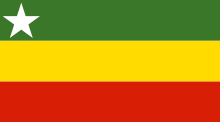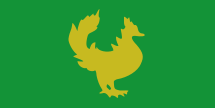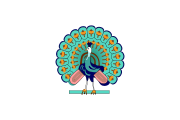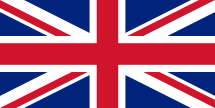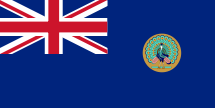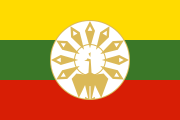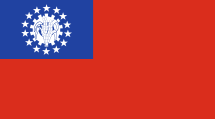- Flag of Burma
-
Flag of Burma (Myanmar)
မြန်မာ နိုင်ငံတော်အလံ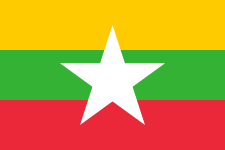
Use National flag and civil and state ensign 
Proportion 2:3[1] Adopted 21 October 2010 Design A horizontal tricolour flag of yellow, green and red charged with a five-pointed white star in the middle of the field. 
Variant flag of Burma (Myanmar)
မြန်မာ နိုင်ငံတော်အလံUse Naval ensign 
Proportion 5:9 Design White field with a red canton charged with a white five-pointed star. A blue anchor in the lower fly.[2] Burma, officially the Republic of the Union of Myanmar, adopted a new state flag on 21 October 2010 to replace the former socialist flag in use since 1974. The new flag was introduced along with implementing changes to the country's name, which were laid out in the 2008 Constitution.
The design of the flag has three horizontal stripes of yellow, green and red with a five-pointed white star in the middle. The three colours of the stripes are meant to symbolise solidarity, peace and tranquility, and courage and decisiveness.[3]
Contents
Colors
Scheme Yellow Green Red White Pantone 116 361 1788 Safe RGB 254-203-0 52-178-51 234-40-57 255-255-255 HTML #FECB00 #34B233 #EA2839 #FFFFFF CMYK 0, 20, 100, 0 71, 0, 71, 30 0, 83, 76, 8 0, 0, 0, 0 Proposals for change
A new design for the national flag was proposed on 10 November 2006 during a constitutional convention. The new flag would have consisted of three equally sized green, yellow, and red horizontal stripes, with a white star in the hoist end of the green stripe.[4]
In September 2007 another new design was proposed, this time with a larger white star in the middle and with the stripes in a different order, namely: yellow, green, red.[4] That same order was used in the flag of the State of Burma during the Japanese occupation of Burma, which featured a green peacock in the centre.
The new flag is basically a fusion of the flag of the State of Burma without the royal peacock, taking instead the white star that symbolised the Union of Burma in the canton of its flag.
Adoption of new flag
The flag proposed in September 2007 was included in the new constitution, and was accepted with the 2008 referendum.[5] Officials were told to lower the old flag in favour of the new one only shortly before 3:00 p.m. local time on 21 October 2010.[3] Orders were also handed out to ensure all old flags were burned.[5] The adoption of the new flag was announced on state media just prior to the flag changing.[3]
The new flag is a horizontal tricolour flag of yellow, green and red charged with a five-pointed white star in the middle of the field. The yellow represents solidarity; the green symbolises peace, tranquility and lush greenery; the red represents courage and determination; and the white star stands for the significance of the union of the country.[4]
History
The two flags used by the country immediately prior to the 2010 flag both originated in the Burmese Resistance, which adopted a red flag with a white star when fighting the occupying Japanese forces during World War II.
The flag adopted upon independence from the United Kingdom on 4 January 1948 consisted of a red field with a blue canton. The blue canton was charged with one large white star, representing the union, surrounded by 5 smaller stars representing the main ethnic groups found within the newly independent state.[6] This flag remained in use until January 1974.[7]
The new flag adopted on 3 January 1974 upon the declaration of a socialist republic by Ne Win depicted 14 stars, encircling a gear and a rice plant in a blue-coloured canton against a red field. The rice stands for agriculture, the gear represents industry, and the 14 stars represent each of the 14 member states of the Union.[4]
Earlier historical flags of Burmese monarchs featured the green peacock. The use of the green peacock was continued during British colonial times and the State of Burma. The flag of the State of Burma (1943–1945) was the yellow-green-red flag with the peacock in the middle. During the last year of the war, a more simplified design of the peacock was also used, probably to rally support amongst the populace.
The flag of the banned National League for Democracy party features both a peacock and a white star, while the National Coalition Government of the Union of Burma used the 1948 flag.
Historic flags
-
The Golden Hintha flag (1300–1500)
-
Flag of Third Burmese Empire under Konbaung dynasty (1752–1885)
-
Flag of British Burma as a colony of British India (1824–1939)
-
Flag of the State of Burma (1943–1945)
-
Simplified flag of the State of Burma (1945)
See also
- Flags of the Burmese states and regions
- State seal of Burma
References
- ^ State Flag Law with State Peace and Development Council Law (8/2010)
- ^ Burmese Flags (Myanmar) from The World Flag Database. Flags.net (2010-10-21). Retrieved on 2011-05-27.
- ^ a b c "Myanmar unveils new flag". AP (Straits Times). 21 October 2010. http://www.straitstimes.com/BreakingNews/SEAsia/Story/STIStory_593613.html. Retrieved 23 October 2010.
- ^ a b c d Tai, Yu-liang. "緬甸 Myanmar/Burma" (in Traditional Chinese). http://www.globalflag.idv.tw/zy/mmr.htm. Retrieved 23 October 2010.
- ^ a b Birsel, Robert (21 October 2010). "Myanmar gets new flag, official name, anthem". Reuters (http://www.webcitation.org/5thEflNof). http://ca.reuters.com/article/topNews/idCATRE69K2HM20101021. Retrieved 23 October 2010.
- ^ Myanmar (Burma) : former flags. Myanmars.net (1948-01-04). Retrieved on 2011-05-27.
- ^ Myanmar (Burma): former flags. Fotw.net. Retrieved on 2011-05-27.
External links
 Media related to Flags of Myanmar at Wikimedia CommonsCategories:
Media related to Flags of Myanmar at Wikimedia CommonsCategories:- Flags of Burma
- National flags
- National symbols of Burma
-
Wikimedia Foundation. 2010.

